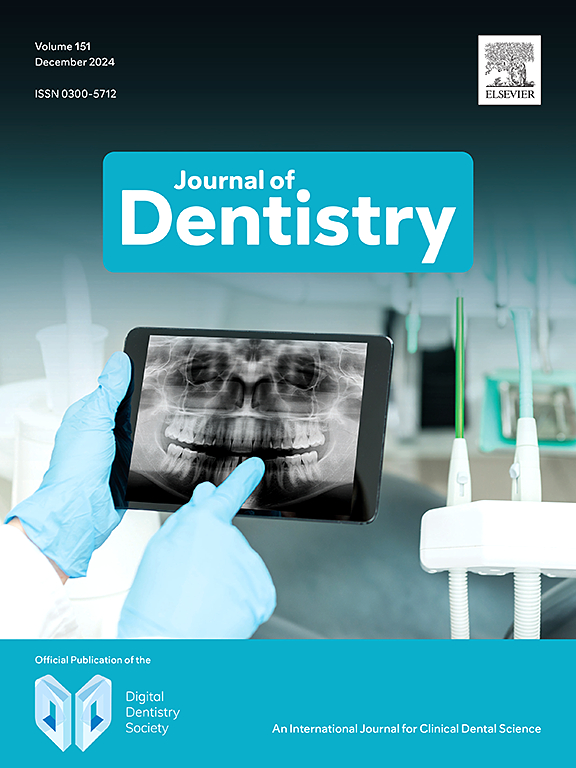Qualitative and quantitative assessment of tooth wear in young individuals
IF 4.8
2区 医学
Q1 DENTISTRY, ORAL SURGERY & MEDICINE
引用次数: 0
Abstract
Objectives
To assess the degree of tooth wear in children and adolescents by application of a qualitative wear index and by quantitative measurement on digital models. The hypothesis was that the quantitative method would be sensitive to reliably measure tooth wear.
Methods
Existing digital models (n = 24) gathered from a prospective clinical study were analysed. The models were obtained at two time points (11–17 months apart) from a cohort of young individuals (11–16 years old) with permanent dentition. Dental wear was scored per sextant on the models according to the qualitative criteria by two examiners and was then quantified on reference teeth (central incisors, canines and first molars). Data were analysed using Cohen's kappa coefficient, Kruskal-Wallis tests followed by Mann-Whitney U, and correlation tests, all with a significance level of 0.05.
Results
According to the qualitative assessment, all subjects showed signs of tooth wear and the severity of scores was higher in the anterior dentition (P ≤ 0.003). Inter-examiner reliability was 0.652 (P < 0.001) while intra-examiner reliability was 0.618 and 0.571 (P < 0.001), respectively. The quantitative analysis showed median tooth wear of 0.09 mm (range: 0 - 0.56 mm). There was no significant correlation between the quantitative measurements of tooth wear and age, sex assigned at birth, time span between scans, or sum of index scores.
Conclusions
The quantitative method was sufficiently sensitive to reliably measure tooth wear on digital models in ≥ 92 % of the investigated teeth. The use of the qualitative wear index on digital models proved dubious due to moderate intra- and inter-reliability ratings.
Clinical significance
Our results show increased prevalence and severity of tooth wear in children and adolescents, which raise concern about the current lifestyle habits in our society. Intraoral scanning can be used to quantify tooth wear at an early stage and thus help design individual strategies to prevent further tooth loss.
青少年牙齿磨损的定性和定量评估。
目的:应用定性磨损指数和数字模型定量测量方法评价儿童青少年牙齿的磨损程度。假设定量方法能灵敏、可靠地测量牙齿磨损。方法:对前瞻性临床研究中收集的现有数字模型(n = 24)进行分析。这些模型是在两个时间点(间隔11-17个月)从一组有恒牙的年轻人(11-16岁)中获得的。由两名审查员根据定性标准对模型的牙齿磨损进行每六分仪评分,然后对参考牙齿(中门牙、犬齿和第一磨牙)进行量化。数据分析采用Cohen’s kappa系数、Kruskal-Wallis检验、Mann-Whitney U检验和相关检验,显著性水平均为0.05。结果:根据定性评估,所有受试者均有牙齿磨损的迹象,且前牙列严重程度评分较高(P≤0.003)。测者间信度为0.652 (P < 0.001),测者内信度为0.618、0.571 (P < 0.001)。定量分析显示中牙磨损量为0.09 mm(范围:0 ~ 0.56 mm)。牙齿磨损的定量测量与年龄、出生性别、扫描间隔时间或指数得分的总和之间没有显著的相关性。结论:定量方法足够灵敏,在数字模型上可靠地测量了≥92%的被调查牙齿的磨损。在数字模型上使用定性磨损指数被证明是可疑的,因为内部和内部的可靠性评级适中。临床意义:我们的研究结果表明,儿童和青少年牙齿磨损的患病率和严重程度都在增加,这引起了我们对当前社会生活习惯的关注。口腔内扫描可用于在早期阶段量化牙齿磨损,从而帮助设计个体策略以防止进一步的牙齿脱落。
本文章由计算机程序翻译,如有差异,请以英文原文为准。
求助全文
约1分钟内获得全文
求助全文
来源期刊

Journal of dentistry
医学-牙科与口腔外科
CiteScore
7.30
自引率
11.40%
发文量
349
审稿时长
35 days
期刊介绍:
The Journal of Dentistry has an open access mirror journal The Journal of Dentistry: X, sharing the same aims and scope, editorial team, submission system and rigorous peer review.
The Journal of Dentistry is the leading international dental journal within the field of Restorative Dentistry. Placing an emphasis on publishing novel and high-quality research papers, the Journal aims to influence the practice of dentistry at clinician, research, industry and policy-maker level on an international basis.
Topics covered include the management of dental disease, periodontology, endodontology, operative dentistry, fixed and removable prosthodontics, dental biomaterials science, long-term clinical trials including epidemiology and oral health, technology transfer of new scientific instrumentation or procedures, as well as clinically relevant oral biology and translational research.
The Journal of Dentistry will publish original scientific research papers including short communications. It is also interested in publishing review articles and leaders in themed areas which will be linked to new scientific research. Conference proceedings are also welcome and expressions of interest should be communicated to the Editor.
 求助内容:
求助内容: 应助结果提醒方式:
应助结果提醒方式:


